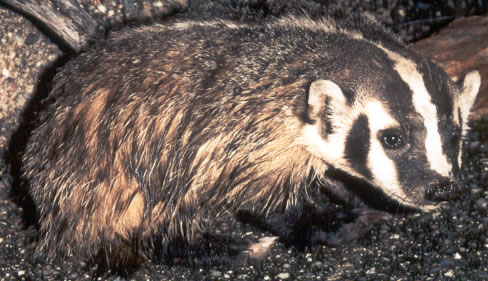American Badger (Taxidea taxus) - Wiki American Badger
From Wikipedia, the free encyclopedia
[Photo] American Badger (Taxidea taxus). Body length: 18 - 22". Diet: Rodents. Like skunks, otters, and wolverines, badgers are members of the weasel family. In addition to their ferocity in encounters with other mammals such as coyotes and domestic dogs, these stout animals are well-known for their digging abilities. With extremely strong claws and muscular legs, badgers construct deep underground dens and dig to find their food, which includes mice, squirrels, birds, and snakes. Badgers appear to be residents at Tonto, and are sometimes observed in the northern areas of the Monument, in the vicinity of Route 188. In general, they favor flat, open areas with few shrubs. Badgers are solitary except during the mating season; two to five offspring are born each year. Source: http://www.nps.gov/tont/nature/badger.htm
The American Badger, Taxidea taxus, is a North American Badger, somewhat similar in appearance to the European Badger.
It is found in the western and central United States, northern Mexico and central Canada. They are found throughout southwestern British Columbia. This animal prefers dry open areas with deep soils that are easy to dig, such as prairie regions.
In Mexico, this animal is sometimes called "tlacoyote". The Spanish word for badger is "tej??n", but in Mexico this word is also used to describe coatis. This can lead to confusion, for there are both coatis and badgers in Mexico.
Taxonomy
The badger is a member of the Mustelidae. This diverse family of carnivorous mammals includes the weasel, ferret, and wolverine. The American Badger belongs to one of three sub-families of badgers, the other two being the Eurasian Badger and the Honey Badger. The American Badger's closest relative is the prehisoric Chamitataxus.
Recognized sub-species include: Taxidea taxus jacksoni, found in the western Great Lakes region; Taxidea taxus jeffersoni, on the west coast of Canada and the US; and Taxidea taxus berlandieri, in the south-western US and in northern Mexico.
Description
American Badgers have a triangular face with a distinctive black and white pattern and a stocky body covered with shaggy grizzled fur. They have short powerful legs with long sharp claws on the front paws and shorter claws on the back paws. This makes it a powerful digging animal.
Behavior
The American Badger is a fossorial carnivore. It preys on ground squirrels, mice, and other small mammals, often digging to pursue prey into their dens, and sometimes plugging tunnel entrances. They also eat birds, snakes and insects. They are mainly active at night, but may be active during the day. They do not hibernate, but become less active in winter. A badger may spend much of the winter in cycles of torpor that last around 29 hours. They do emerge from their dens on warmer days.
Badgers are normally solitary animals for most of the year, but it is thought that in breeding season they expand their territories to actively seek out mates. Males may breed with more than one female. Mating occurs in the summer, but implantation is delayed and the young are born in an underground burrow during late winter. Litters consist of one to five offspring.
Further Information
They have few natural predators other than humans. The numbers of these animals has declined due to persecution by farmers and the extermination of many of their prey in agricultural areas. In May 2000, the Canadian Species at Risk Act listed both the American Badger jacksoni subspecies (Taxidea taxus jacksoni) and the jeffersonii subspecies (Taxidea taxus jeffersonii) as an endangered species in Canada.
Cultural references
The state animal of Wisconsin is the badger, so named for the lead miners who lived in holes in the ground during the lead rush of the 1840's. Because of this the University of Wisconsin-Madison's sports team name is the Badgers and their mascot is Bucky Badger.
http://en.wikipedia.org/wiki/American_Badger
| The text in this page is based on the copyrighted Wikipedia article shown in above URL. It is used under the GNU Free Documentation License. You may redistribute it, verbatim or modified, providing that you comply with the terms of the GFDL. |
